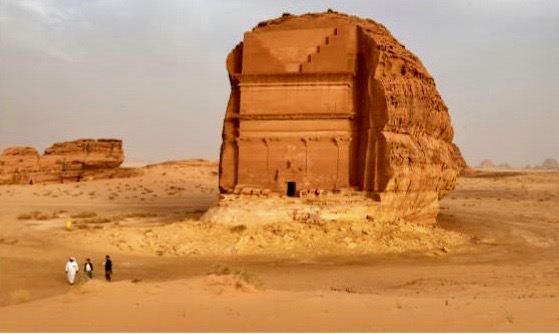ANNALISA DEL VECCHIO WRITES – It could well become the most noticed new archaeological site in the world. Imagine an open air museum, a tourist site and a display of ancient history rolled into one. This is the future Al-Ula, a project that France and Saudi Arabia agreed jointly to develop last year.
Al-Ula, an archaeological site located about 1100 kilometers from Riyadh, will contain ancient cultural artifacts dating back a thousand years, towering sandstone mountains and a lush oasis valley http://www.saudiarabiatourismguide.com/al-ula/ stretching across 22,561 kilometers. A helicopter view of the desert landscape looks like an inspired maze of rock formations.
Al-Ula will be the first Saudi Arabian site registered on the World Heritage list. It will be a first for tourists, too, as they view inscriptions of great historical significance and engravings etched onto immense rock surfaces. Some of these inscriptions are about two thousand years old and show the names of tribes as well as the laws of the people that used to inhabit the area. They will see more than one hundred sets of first century BC tombs that have been remarkably well preserved.
Some of the monuments show pre-Islamic inscriptions and drawings, such as hunting pictures depicting the legacy of the Nabataean artistic tradition. Other rock art will reveal the mysteries of civilizations on the Arabian Peninsula, like the Manaens who belonged to the Lihyanite and Yemens of Arabia. And there will be cultural treasures such as the Lkmah Mountain.
According to archaeologists, the story of prophet Saleh happened in Al-Ula. Thamudians are believed to be the first people to inhabit the area, carving houses out of rocks. The strength of these people and the style of their dwellings are mentioned in the Quran. There is evidence, too, of people living in Mada’in Saleh. The Al-Didan kingdom settled in the area, followed by the Lihyan and the Nabataens,who created graves. And there is considerable religious history in the Judaic, Islamic and Christian traditions. Researchers who discovered forty-six lakes that are believed to have existed in Saudi Arabia take this to mean that the area was characterized by alternating periods of wet climates and desertification.
 Saudi Arabia aims to welcome about 1.5 to 2 million people annually in Ul-Ala’s first three to five years. Already, the site has drawn tourists from various continents—a sum total of roughly twenty thousand visitors per year. Imagine bringing the experience of ancient times back to today, and to the future. Tourists will witness, first-hand, representations of civilizations and events that occurred seven thousand years ago. Al-Ula is no tourist trap. It is art, history— and art history in the making.
Saudi Arabia aims to welcome about 1.5 to 2 million people annually in Ul-Ala’s first three to five years. Already, the site has drawn tourists from various continents—a sum total of roughly twenty thousand visitors per year. Imagine bringing the experience of ancient times back to today, and to the future. Tourists will witness, first-hand, representations of civilizations and events that occurred seven thousand years ago. Al-Ula is no tourist trap. It is art, history— and art history in the making.


